Discussing Social Media's Impact on Lifelong Learning - B.Ed (Hons)
VerifiedAdded on 2022/09/28
|8
|2084
|25
Essay
AI Summary
This essay discusses the profound impact of social media on the lifelong learning process, particularly within the context of higher education. It explores how social media has transformed the way students access information, communicate, and collaborate, acknowledging its integration into modern culture. The essay delves into both the positive and negative effects of social media, highlighting how it can enhance learning through interactive platforms and facilitate information sharing while also potentially leading to distractions, decreased academic performance, and reduced social skills. The analysis considers the role of social media in shaping student behavior, influencing academic outcomes, and changing the dynamics of education. The essay concludes by emphasizing the need for students, parents, and educators to understand and manage social media usage to maximize its benefits and mitigate its drawbacks, promoting effective lifelong learning.
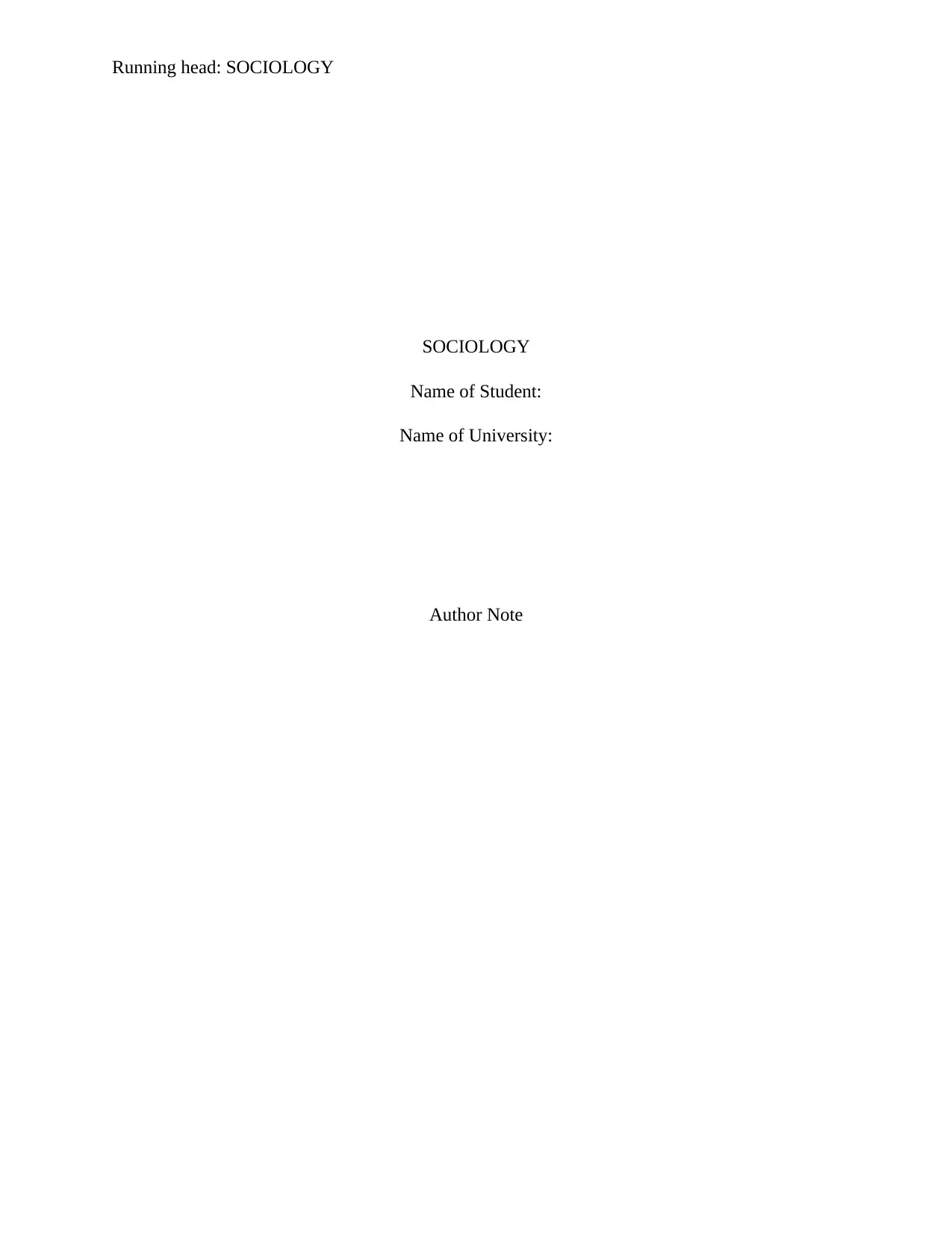
Running head: SOCIOLOGY
SOCIOLOGY
Name of Student:
Name of University:
Author Note
SOCIOLOGY
Name of Student:
Name of University:
Author Note
Paraphrase This Document
Need a fresh take? Get an instant paraphrase of this document with our AI Paraphraser
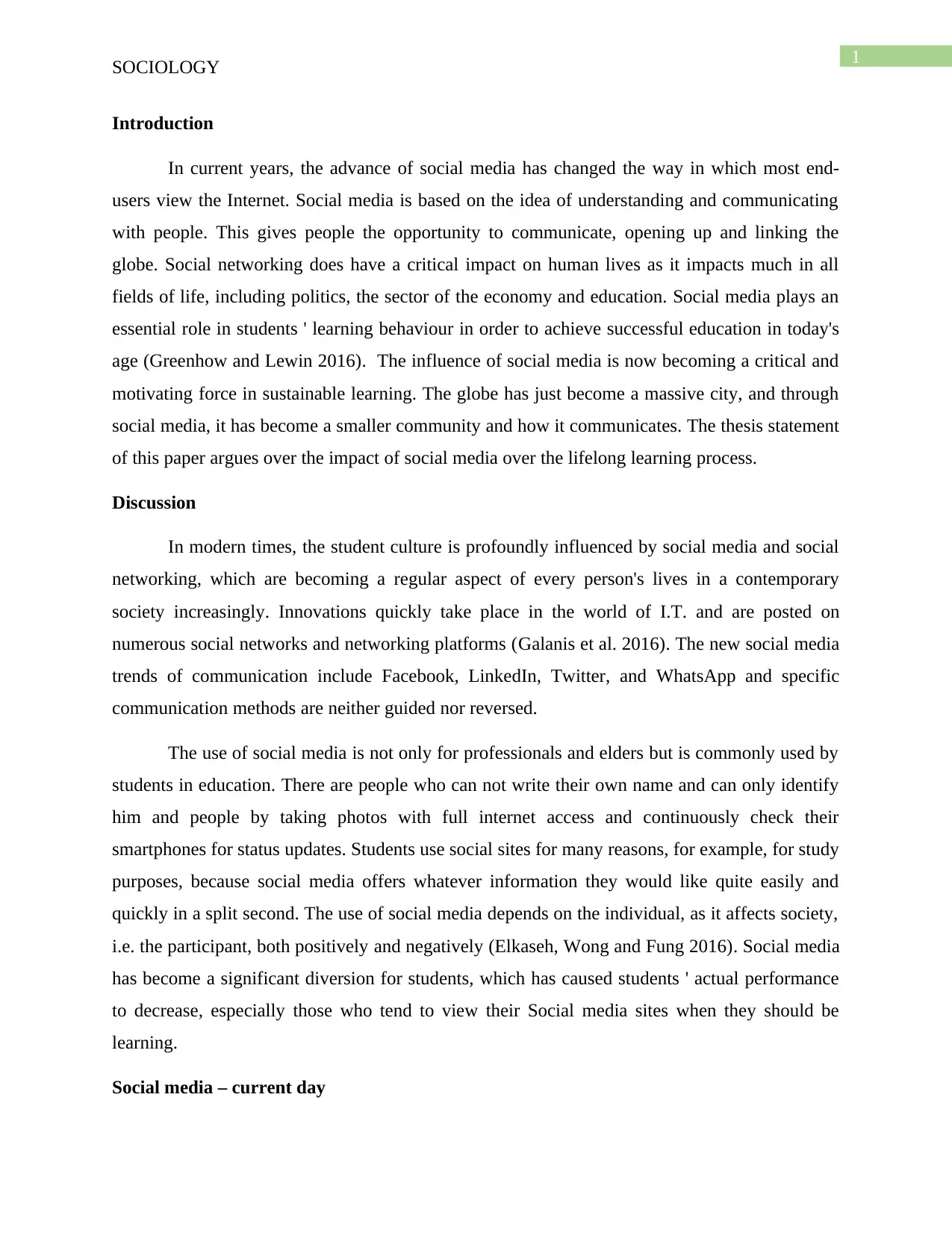
1
SOCIOLOGY
Introduction
In current years, the advance of social media has changed the way in which most end-
users view the Internet. Social media is based on the idea of understanding and communicating
with people. This gives people the opportunity to communicate, opening up and linking the
globe. Social networking does have a critical impact on human lives as it impacts much in all
fields of life, including politics, the sector of the economy and education. Social media plays an
essential role in students ' learning behaviour in order to achieve successful education in today's
age (Greenhow and Lewin 2016). The influence of social media is now becoming a critical and
motivating force in sustainable learning. The globe has just become a massive city, and through
social media, it has become a smaller community and how it communicates. The thesis statement
of this paper argues over the impact of social media over the lifelong learning process.
Discussion
In modern times, the student culture is profoundly influenced by social media and social
networking, which are becoming a regular aspect of every person's lives in a contemporary
society increasingly. Innovations quickly take place in the world of I.T. and are posted on
numerous social networks and networking platforms (Galanis et al. 2016). The new social media
trends of communication include Facebook, LinkedIn, Twitter, and WhatsApp and specific
communication methods are neither guided nor reversed.
The use of social media is not only for professionals and elders but is commonly used by
students in education. There are people who can not write their own name and can only identify
him and people by taking photos with full internet access and continuously check their
smartphones for status updates. Students use social sites for many reasons, for example, for study
purposes, because social media offers whatever information they would like quite easily and
quickly in a split second. The use of social media depends on the individual, as it affects society,
i.e. the participant, both positively and negatively (Elkaseh, Wong and Fung 2016). Social media
has become a significant diversion for students, which has caused students ' actual performance
to decrease, especially those who tend to view their Social media sites when they should be
learning.
Social media – current day
SOCIOLOGY
Introduction
In current years, the advance of social media has changed the way in which most end-
users view the Internet. Social media is based on the idea of understanding and communicating
with people. This gives people the opportunity to communicate, opening up and linking the
globe. Social networking does have a critical impact on human lives as it impacts much in all
fields of life, including politics, the sector of the economy and education. Social media plays an
essential role in students ' learning behaviour in order to achieve successful education in today's
age (Greenhow and Lewin 2016). The influence of social media is now becoming a critical and
motivating force in sustainable learning. The globe has just become a massive city, and through
social media, it has become a smaller community and how it communicates. The thesis statement
of this paper argues over the impact of social media over the lifelong learning process.
Discussion
In modern times, the student culture is profoundly influenced by social media and social
networking, which are becoming a regular aspect of every person's lives in a contemporary
society increasingly. Innovations quickly take place in the world of I.T. and are posted on
numerous social networks and networking platforms (Galanis et al. 2016). The new social media
trends of communication include Facebook, LinkedIn, Twitter, and WhatsApp and specific
communication methods are neither guided nor reversed.
The use of social media is not only for professionals and elders but is commonly used by
students in education. There are people who can not write their own name and can only identify
him and people by taking photos with full internet access and continuously check their
smartphones for status updates. Students use social sites for many reasons, for example, for study
purposes, because social media offers whatever information they would like quite easily and
quickly in a split second. The use of social media depends on the individual, as it affects society,
i.e. the participant, both positively and negatively (Elkaseh, Wong and Fung 2016). Social media
has become a significant diversion for students, which has caused students ' actual performance
to decrease, especially those who tend to view their Social media sites when they should be
learning.
Social media – current day
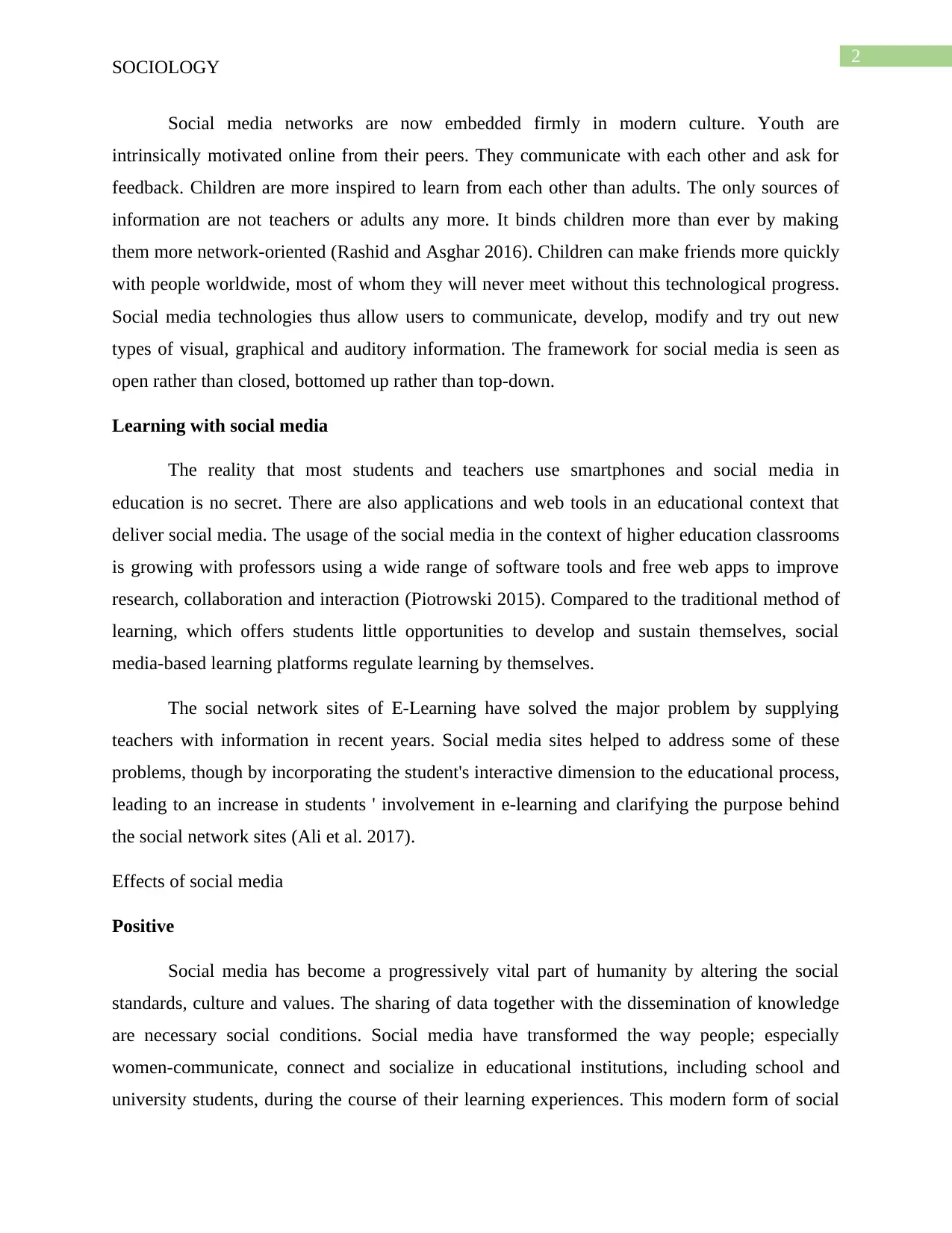
2
SOCIOLOGY
Social media networks are now embedded firmly in modern culture. Youth are
intrinsically motivated online from their peers. They communicate with each other and ask for
feedback. Children are more inspired to learn from each other than adults. The only sources of
information are not teachers or adults any more. It binds children more than ever by making
them more network-oriented (Rashid and Asghar 2016). Children can make friends more quickly
with people worldwide, most of whom they will never meet without this technological progress.
Social media technologies thus allow users to communicate, develop, modify and try out new
types of visual, graphical and auditory information. The framework for social media is seen as
open rather than closed, bottomed up rather than top-down.
Learning with social media
The reality that most students and teachers use smartphones and social media in
education is no secret. There are also applications and web tools in an educational context that
deliver social media. The usage of the social media in the context of higher education classrooms
is growing with professors using a wide range of software tools and free web apps to improve
research, collaboration and interaction (Piotrowski 2015). Compared to the traditional method of
learning, which offers students little opportunities to develop and sustain themselves, social
media-based learning platforms regulate learning by themselves.
The social network sites of E-Learning have solved the major problem by supplying
teachers with information in recent years. Social media sites helped to address some of these
problems, though by incorporating the student's interactive dimension to the educational process,
leading to an increase in students ' involvement in e-learning and clarifying the purpose behind
the social network sites (Ali et al. 2017).
Effects of social media
Positive
Social media has become a progressively vital part of humanity by altering the social
standards, culture and values. The sharing of data together with the dissemination of knowledge
are necessary social conditions. Social media have transformed the way people; especially
women-communicate, connect and socialize in educational institutions, including school and
university students, during the course of their learning experiences. This modern form of social
SOCIOLOGY
Social media networks are now embedded firmly in modern culture. Youth are
intrinsically motivated online from their peers. They communicate with each other and ask for
feedback. Children are more inspired to learn from each other than adults. The only sources of
information are not teachers or adults any more. It binds children more than ever by making
them more network-oriented (Rashid and Asghar 2016). Children can make friends more quickly
with people worldwide, most of whom they will never meet without this technological progress.
Social media technologies thus allow users to communicate, develop, modify and try out new
types of visual, graphical and auditory information. The framework for social media is seen as
open rather than closed, bottomed up rather than top-down.
Learning with social media
The reality that most students and teachers use smartphones and social media in
education is no secret. There are also applications and web tools in an educational context that
deliver social media. The usage of the social media in the context of higher education classrooms
is growing with professors using a wide range of software tools and free web apps to improve
research, collaboration and interaction (Piotrowski 2015). Compared to the traditional method of
learning, which offers students little opportunities to develop and sustain themselves, social
media-based learning platforms regulate learning by themselves.
The social network sites of E-Learning have solved the major problem by supplying
teachers with information in recent years. Social media sites helped to address some of these
problems, though by incorporating the student's interactive dimension to the educational process,
leading to an increase in students ' involvement in e-learning and clarifying the purpose behind
the social network sites (Ali et al. 2017).
Effects of social media
Positive
Social media has become a progressively vital part of humanity by altering the social
standards, culture and values. The sharing of data together with the dissemination of knowledge
are necessary social conditions. Social media have transformed the way people; especially
women-communicate, connect and socialize in educational institutions, including school and
university students, during the course of their learning experiences. This modern form of social
⊘ This is a preview!⊘
Do you want full access?
Subscribe today to unlock all pages.

Trusted by 1+ million students worldwide
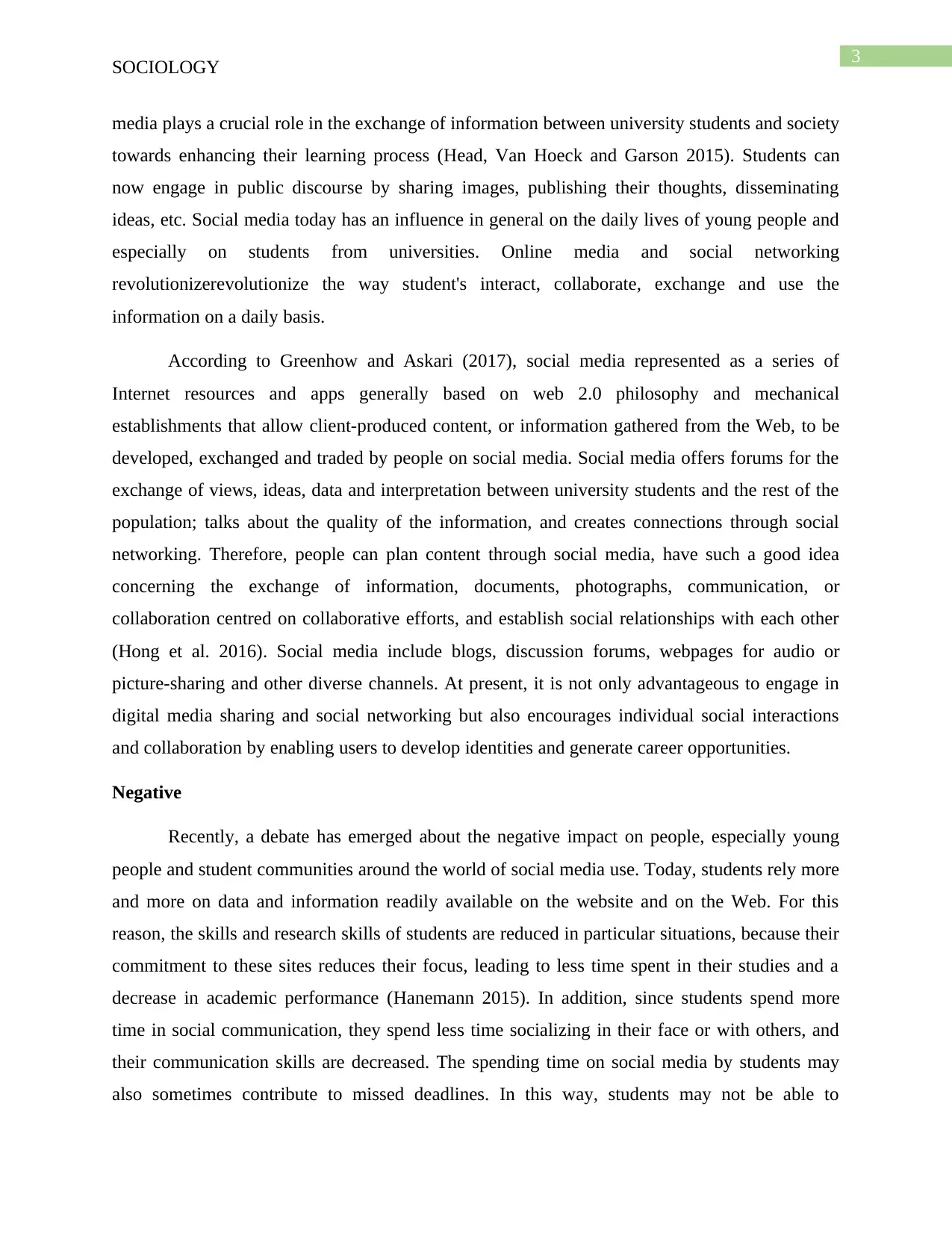
3
SOCIOLOGY
media plays a crucial role in the exchange of information between university students and society
towards enhancing their learning process (Head, Van Hoeck and Garson 2015). Students can
now engage in public discourse by sharing images, publishing their thoughts, disseminating
ideas, etc. Social media today has an influence in general on the daily lives of young people and
especially on students from universities. Online media and social networking
revolutionizerevolutionize the way student's interact, collaborate, exchange and use the
information on a daily basis.
According to Greenhow and Askari (2017), social media represented as a series of
Internet resources and apps generally based on web 2.0 philosophy and mechanical
establishments that allow client-produced content, or information gathered from the Web, to be
developed, exchanged and traded by people on social media. Social media offers forums for the
exchange of views, ideas, data and interpretation between university students and the rest of the
population; talks about the quality of the information, and creates connections through social
networking. Therefore, people can plan content through social media, have such a good idea
concerning the exchange of information, documents, photographs, communication, or
collaboration centred on collaborative efforts, and establish social relationships with each other
(Hong et al. 2016). Social media include blogs, discussion forums, webpages for audio or
picture-sharing and other diverse channels. At present, it is not only advantageous to engage in
digital media sharing and social networking but also encourages individual social interactions
and collaboration by enabling users to develop identities and generate career opportunities.
Negative
Recently, a debate has emerged about the negative impact on people, especially young
people and student communities around the world of social media use. Today, students rely more
and more on data and information readily available on the website and on the Web. For this
reason, the skills and research skills of students are reduced in particular situations, because their
commitment to these sites reduces their focus, leading to less time spent in their studies and a
decrease in academic performance (Hanemann 2015). In addition, since students spend more
time in social communication, they spend less time socializing in their face or with others, and
their communication skills are decreased. The spending time on social media by students may
also sometimes contribute to missed deadlines. In this way, students may not be able to
SOCIOLOGY
media plays a crucial role in the exchange of information between university students and society
towards enhancing their learning process (Head, Van Hoeck and Garson 2015). Students can
now engage in public discourse by sharing images, publishing their thoughts, disseminating
ideas, etc. Social media today has an influence in general on the daily lives of young people and
especially on students from universities. Online media and social networking
revolutionizerevolutionize the way student's interact, collaborate, exchange and use the
information on a daily basis.
According to Greenhow and Askari (2017), social media represented as a series of
Internet resources and apps generally based on web 2.0 philosophy and mechanical
establishments that allow client-produced content, or information gathered from the Web, to be
developed, exchanged and traded by people on social media. Social media offers forums for the
exchange of views, ideas, data and interpretation between university students and the rest of the
population; talks about the quality of the information, and creates connections through social
networking. Therefore, people can plan content through social media, have such a good idea
concerning the exchange of information, documents, photographs, communication, or
collaboration centred on collaborative efforts, and establish social relationships with each other
(Hong et al. 2016). Social media include blogs, discussion forums, webpages for audio or
picture-sharing and other diverse channels. At present, it is not only advantageous to engage in
digital media sharing and social networking but also encourages individual social interactions
and collaboration by enabling users to develop identities and generate career opportunities.
Negative
Recently, a debate has emerged about the negative impact on people, especially young
people and student communities around the world of social media use. Today, students rely more
and more on data and information readily available on the website and on the Web. For this
reason, the skills and research skills of students are reduced in particular situations, because their
commitment to these sites reduces their focus, leading to less time spent in their studies and a
decrease in academic performance (Hanemann 2015). In addition, since students spend more
time in social communication, they spend less time socializing in their face or with others, and
their communication skills are decreased. The spending time on social media by students may
also sometimes contribute to missed deadlines. In this way, students may not be able to
Paraphrase This Document
Need a fresh take? Get an instant paraphrase of this document with our AI Paraphraser
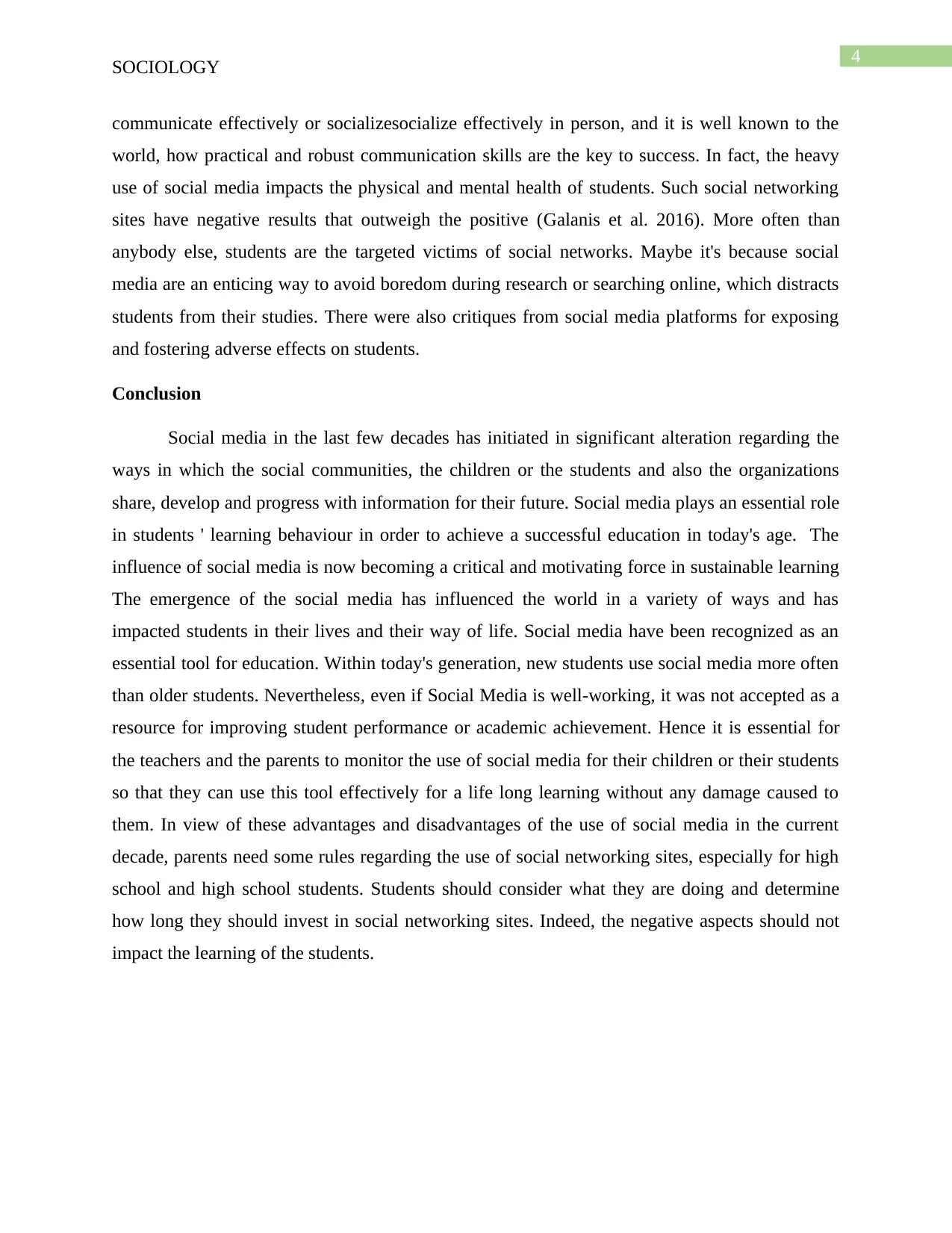
4
SOCIOLOGY
communicate effectively or socializesocialize effectively in person, and it is well known to the
world, how practical and robust communication skills are the key to success. In fact, the heavy
use of social media impacts the physical and mental health of students. Such social networking
sites have negative results that outweigh the positive (Galanis et al. 2016). More often than
anybody else, students are the targeted victims of social networks. Maybe it's because social
media are an enticing way to avoid boredom during research or searching online, which distracts
students from their studies. There were also critiques from social media platforms for exposing
and fostering adverse effects on students.
Conclusion
Social media in the last few decades has initiated in significant alteration regarding the
ways in which the social communities, the children or the students and also the organizations
share, develop and progress with information for their future. Social media plays an essential role
in students ' learning behaviour in order to achieve a successful education in today's age. The
influence of social media is now becoming a critical and motivating force in sustainable learning
The emergence of the social media has influenced the world in a variety of ways and has
impacted students in their lives and their way of life. Social media have been recognized as an
essential tool for education. Within today's generation, new students use social media more often
than older students. Nevertheless, even if Social Media is well-working, it was not accepted as a
resource for improving student performance or academic achievement. Hence it is essential for
the teachers and the parents to monitor the use of social media for their children or their students
so that they can use this tool effectively for a life long learning without any damage caused to
them. In view of these advantages and disadvantages of the use of social media in the current
decade, parents need some rules regarding the use of social networking sites, especially for high
school and high school students. Students should consider what they are doing and determine
how long they should invest in social networking sites. Indeed, the negative aspects should not
impact the learning of the students.
SOCIOLOGY
communicate effectively or socializesocialize effectively in person, and it is well known to the
world, how practical and robust communication skills are the key to success. In fact, the heavy
use of social media impacts the physical and mental health of students. Such social networking
sites have negative results that outweigh the positive (Galanis et al. 2016). More often than
anybody else, students are the targeted victims of social networks. Maybe it's because social
media are an enticing way to avoid boredom during research or searching online, which distracts
students from their studies. There were also critiques from social media platforms for exposing
and fostering adverse effects on students.
Conclusion
Social media in the last few decades has initiated in significant alteration regarding the
ways in which the social communities, the children or the students and also the organizations
share, develop and progress with information for their future. Social media plays an essential role
in students ' learning behaviour in order to achieve a successful education in today's age. The
influence of social media is now becoming a critical and motivating force in sustainable learning
The emergence of the social media has influenced the world in a variety of ways and has
impacted students in their lives and their way of life. Social media have been recognized as an
essential tool for education. Within today's generation, new students use social media more often
than older students. Nevertheless, even if Social Media is well-working, it was not accepted as a
resource for improving student performance or academic achievement. Hence it is essential for
the teachers and the parents to monitor the use of social media for their children or their students
so that they can use this tool effectively for a life long learning without any damage caused to
them. In view of these advantages and disadvantages of the use of social media in the current
decade, parents need some rules regarding the use of social networking sites, especially for high
school and high school students. Students should consider what they are doing and determine
how long they should invest in social networking sites. Indeed, the negative aspects should not
impact the learning of the students.
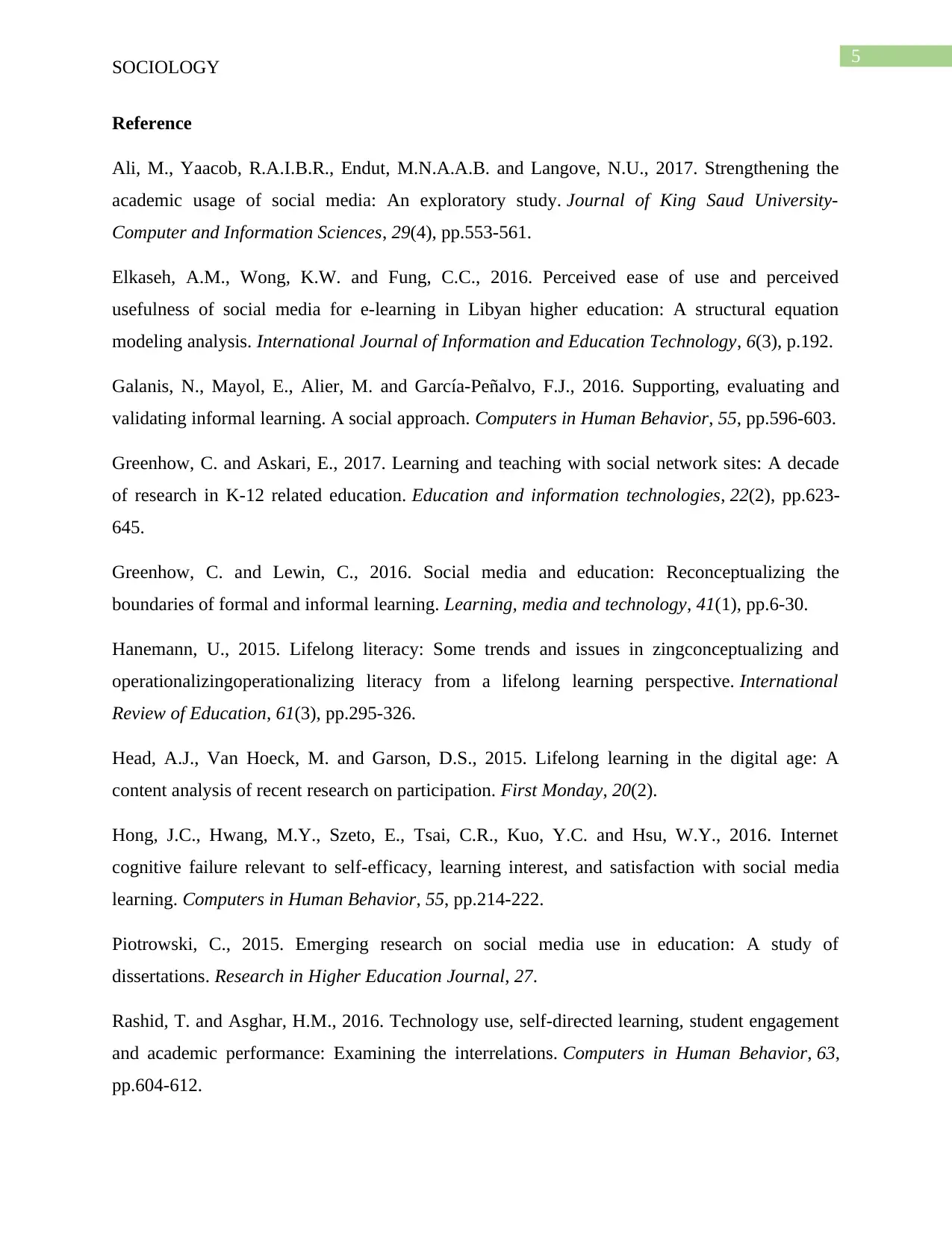
5
SOCIOLOGY
Reference
Ali, M., Yaacob, R.A.I.B.R., Endut, M.N.A.A.B. and Langove, N.U., 2017. Strengthening the
academic usage of social media: An exploratory study. Journal of King Saud University-
Computer and Information Sciences, 29(4), pp.553-561.
Elkaseh, A.M., Wong, K.W. and Fung, C.C., 2016. Perceived ease of use and perceived
usefulness of social media for e-learning in Libyan higher education: A structural equation
modeling analysis. International Journal of Information and Education Technology, 6(3), p.192.
Galanis, N., Mayol, E., Alier, M. and García-Peñalvo, F.J., 2016. Supporting, evaluating and
validating informal learning. A social approach. Computers in Human Behavior, 55, pp.596-603.
Greenhow, C. and Askari, E., 2017. Learning and teaching with social network sites: A decade
of research in K-12 related education. Education and information technologies, 22(2), pp.623-
645.
Greenhow, C. and Lewin, C., 2016. Social media and education: Reconceptualizing the
boundaries of formal and informal learning. Learning, media and technology, 41(1), pp.6-30.
Hanemann, U., 2015. Lifelong literacy: Some trends and issues in zingconceptualizing and
operationalizingoperationalizing literacy from a lifelong learning perspective. International
Review of Education, 61(3), pp.295-326.
Head, A.J., Van Hoeck, M. and Garson, D.S., 2015. Lifelong learning in the digital age: A
content analysis of recent research on participation. First Monday, 20(2).
Hong, J.C., Hwang, M.Y., Szeto, E., Tsai, C.R., Kuo, Y.C. and Hsu, W.Y., 2016. Internet
cognitive failure relevant to self-efficacy, learning interest, and satisfaction with social media
learning. Computers in Human Behavior, 55, pp.214-222.
Piotrowski, C., 2015. Emerging research on social media use in education: A study of
dissertations. Research in Higher Education Journal, 27.
Rashid, T. and Asghar, H.M., 2016. Technology use, self-directed learning, student engagement
and academic performance: Examining the interrelations. Computers in Human Behavior, 63,
pp.604-612.
SOCIOLOGY
Reference
Ali, M., Yaacob, R.A.I.B.R., Endut, M.N.A.A.B. and Langove, N.U., 2017. Strengthening the
academic usage of social media: An exploratory study. Journal of King Saud University-
Computer and Information Sciences, 29(4), pp.553-561.
Elkaseh, A.M., Wong, K.W. and Fung, C.C., 2016. Perceived ease of use and perceived
usefulness of social media for e-learning in Libyan higher education: A structural equation
modeling analysis. International Journal of Information and Education Technology, 6(3), p.192.
Galanis, N., Mayol, E., Alier, M. and García-Peñalvo, F.J., 2016. Supporting, evaluating and
validating informal learning. A social approach. Computers in Human Behavior, 55, pp.596-603.
Greenhow, C. and Askari, E., 2017. Learning and teaching with social network sites: A decade
of research in K-12 related education. Education and information technologies, 22(2), pp.623-
645.
Greenhow, C. and Lewin, C., 2016. Social media and education: Reconceptualizing the
boundaries of formal and informal learning. Learning, media and technology, 41(1), pp.6-30.
Hanemann, U., 2015. Lifelong literacy: Some trends and issues in zingconceptualizing and
operationalizingoperationalizing literacy from a lifelong learning perspective. International
Review of Education, 61(3), pp.295-326.
Head, A.J., Van Hoeck, M. and Garson, D.S., 2015. Lifelong learning in the digital age: A
content analysis of recent research on participation. First Monday, 20(2).
Hong, J.C., Hwang, M.Y., Szeto, E., Tsai, C.R., Kuo, Y.C. and Hsu, W.Y., 2016. Internet
cognitive failure relevant to self-efficacy, learning interest, and satisfaction with social media
learning. Computers in Human Behavior, 55, pp.214-222.
Piotrowski, C., 2015. Emerging research on social media use in education: A study of
dissertations. Research in Higher Education Journal, 27.
Rashid, T. and Asghar, H.M., 2016. Technology use, self-directed learning, student engagement
and academic performance: Examining the interrelations. Computers in Human Behavior, 63,
pp.604-612.
⊘ This is a preview!⊘
Do you want full access?
Subscribe today to unlock all pages.

Trusted by 1+ million students worldwide

6
SOCIOLOGY
SOCIOLOGY
Paraphrase This Document
Need a fresh take? Get an instant paraphrase of this document with our AI Paraphraser

7
SOCIOLOGY
SOCIOLOGY
1 out of 8
Related Documents
Your All-in-One AI-Powered Toolkit for Academic Success.
+13062052269
info@desklib.com
Available 24*7 on WhatsApp / Email
![[object Object]](/_next/static/media/star-bottom.7253800d.svg)
Unlock your academic potential
Copyright © 2020–2025 A2Z Services. All Rights Reserved. Developed and managed by ZUCOL.





